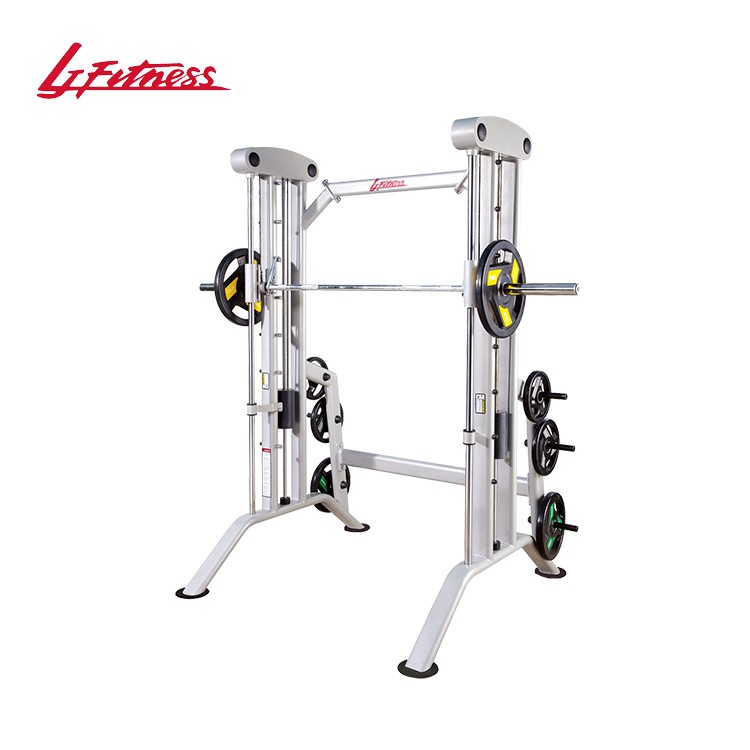To calculate the weight you need to lift on a Smith machine, follow these steps:
1. **Determine Your Goal**: Before calculating your weight, it's important to know what you're aiming for. Are you trying to lift a certain amount of weight for a specific number of reps or increase your strength in a particular exercise?
2. **Choose an Exercise**: Decide which exercise you're focusing on, such as squats, bench press, or deadlifts. Each exercise has different considerations when determining the appropriate weight.
3. **Know Your Body Weight**: Understanding your body weight is crucial because some exercises may require more weight relative to your body size. For example, bodyweight exercises like pull-ups will require less additional weight compared to squatting.
4. **Consider Your Fitness Level**: If you're a beginner, start with lighter weights and focus on form and technique. As you progress, you can increase the weight gradually.
5. **Set a Target**: Based on your goal (e.g., lifting 100 pounds for 8 reps), you'll need to determine how much weight to add to the bar. The formula can vary depending on the exercise, but generally, you might aim for a weight that allows you to complete your desired number of reps with proper form.
6. **Use the Smith Machine's Weight Selection**: Most Smith machines have adjustable bars or weights attached to the bar. You can manually adjust the weight using plates or, if available, a weight stack.
- **Manual Adjustment**: Attach the appropriate number of weight plates based on your calculated target weight.
- **Weight Stack Adjustment**: Adjust the lever to select the desired weight from the stack. This is often done by pulling down on the lever until the weight indicator shows your chosen weight.
7. **Check Your Form**: Ensure you maintain proper form throughout your workout. Incorrect form can lead to injuries and may not be as effective for strength gains.
8. **Progress Gradually**: As you get stronger, increase the weight incrementally. A good rule of thumb is to increase the weight by about 5-10% each time you feel comfortable performing the desired number of reps.
9. **Monitor Progress**: Keep track of your workouts, including the weights you use and the number of reps you perform. This will help you see improvements over time and adjust your training accordingly.
Remember, safety is paramount when using any gym equipment. Always warm up properly before starting your workout, and consider working with a trainer or a spotter, especially if you're new to using a Smith machine.
Do you need a spotter with a Smith machine?
A Smith machine is designed to provide a safer and more controlled environment for weightlifting exercises, especially for movements that target the upper body like bench press or overhead press. Unlike traditional free-weight exercises where a spotter is essential for safety reasons, the use of a spotter with a Smith machine can be optional depending on your comfort level, experience, and the specific exercise being performed.
Here are a few points to consider:
1. **Safety**: The Smith machine is designed to limit the range of motion during exercises, which can reduce the risk of injury compared to traditional free weights. However, it does not completely eliminate the risk. If you're performing exercises that involve significant movement, such as squats or deadlifts, having a spotter can still be beneficial in case of equipment failure or loss of balance.
2. **Experience**: For beginners or those who are new to using a Smith machine, it might be wise to have someone nearby who understands the proper form and can assist if needed. This can help ensure that you perform the exercises correctly and avoid potential injuries.
3. **Comfort**: Some lifters feel more comfortable exercising without a spotter, particularly when they are confident in their abilities. As long as you are aware of your limits and can safely perform the exercises without assistance, there's no strict rule requiring a spotter.
4. **Specific Exercises**: For certain exercises like barbell squats or deadlifts, a spotter is typically necessary for safety reasons. Since the Smith machine replicates these movements but with a fixed path, the need for a spotter might be less critical, but it still depends on the individual's confidence and the specific exercise.
In summary, while a spotter is not strictly required with a Smith machine, having one can add an extra layer of safety, especially for those who are not as experienced or confident in their lifting abilities. It's important to weigh your personal comfort and safety concerns when deciding whether to use a spotter.
How much does the force Smith machine bar weigh?
The weight of a Smith machine bar can vary depending on the specific model and manufacturer. Typically, Smith machine bars are made to be similar in size and weight to Olympic bars, which range from 20 to 45 pounds (9 to 20 kilograms) without plates.
However, the actual weight of the bar itself (without any added weight plates) is usually around 45 pounds (20 kilograms). This weight allows for the addition of plates for varying levels of resistance during exercises like squats, bench presses, and deadlifts.
It's important to note that some high-end or custom-made Smith machines may offer different bar weights or options, so it's always best to check the specifications provided by the manufacturer for the exact weight of the bar you're interested in.
How heavy is the Smith machine bar Anytime Fitness?
The weight of the barbell used in a Smith machine can vary depending on the specific model and the gym's equipment. Typically, standard Olympic bars weigh around 45 pounds (20.4 kg) including the collars. However, some gyms might have different weights, especially if they offer specialized or commercial-grade equipment.
To get an exact weight for the Smith machine bar at Anytime Fitness or any other gym, you should contact the specific gym location directly. They would be able to provide accurate information about their equipment, as it can vary by facility.





















